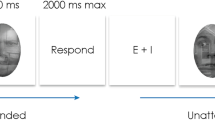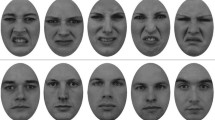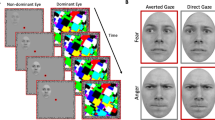Abstract
Fearful facial expressions are important social indicators of environmental threat. Among the various features of a fearful face, the eyes appear to be particularly important for recognizing and responding to these social cues. One way in which fearful faces facilitate observers’ behavior is by automatically capturing attention. This is true for both consciously and nonconsciously processed fearful faces. Recent research suggests that consciously processed fearful eyes alone are sufficient to capture observers’ attention. However, it is unknown as to whether or not nonconsciously processed, backward masked, fearful eyes are sufficient to facilitate spatial attention. To test this possibility, two dot-probe experiments with masked fearful eye stimuli were performed. In Experiment 1, we found that, relative to scrambled eyes, masked fearful eyes facilitate attentional orienting and delay attentional disengagement. In Experiment 2, we replicated this effect when comparing backward masked fearful to neutral eyes. Thus, the data suggest that nonconscious fearful eyes facilitate spatial attention through facilitated orienting and delayed disengagement.

Similar content being viewed by others
References
Adolphs, R., Tranel, D., Hamann, S., Young, A. W., Calder, A. J., Phelps, E. A., & Damasio, A. R. (1999). Recognition of facial emotion in nine individuals with bilateral amygdala damage. Neuropsychologia, 37(10), 1111–1117.
Adolphs, R., Gosselin, F., Buchanan, T. W., Tranel, D., Schyns, P., & Damasio, A. R. (2005). A mechanism for impaired fear recognition after amygdala damage. Nature, 433(7021), 68–72.
Akiyama, T., Kato, M., Muramatsu, T., Umeda, S., Saito, F., & Kashima, H. (2007). Unilateral amygdala lesions hamper attentional orienting triggered by gaze direction. [Research Support, Non-U.S. Gov’t]. Cerebral Cortex, 17(11), 2593–2600. doi:10.1093/cercor/bhl166.
Anderson, A. K., & Phelps, E. A. (2001). Lesions of the human amygdala impair enhanced perception of emotionally salient events. Nature, 411(6835), 305–309.
Armony, J. L., & Dolan, R. J. (2002). Modulation of spatial attention by fear-conditioned stimuli: An event-related fMRI study. Neuropsychologia, 40(7), 817–826.
Armony, J. L., Corbo, V., Clement, M. H., & Brunet, A. (2005). Amygdala response in patients with acute PTSD to masked and unmasked emotional facial expressions. American Journal of Psychiatry, 162(10), 1961–1963.
Ashwin, C., Baron-Cohen, S., Wheelwright, S., O’Riordan, M., & Bullmore, E. T. (2007). Differential activation of the amygdala and the ‘social brain’ during fearful face-processing in Asperger Syndrome. Neuropsychologia, 45(1), 2–14. doi:10.1016/j.neuropsychologia.2006.04.014.
Bach, D. R., Hurlemann, R., & Dolan, R. J. (2014). Impaired threat prioritisation after selective bilateral amygdala lesions. Cortex, 63C, 206–213. doi:10.1016/j.cortex.2014.08.017.
Beaver, J. D., Mogg, K., & Bradley, B. P. (2005). Emotional conditioning to masked stimuli and modulation of visuospatial attention. Emotion, 5(1), 67–79.
Blanchette, I. (2006). Snakes, spiders, guns, and syringes: How specific are evolutionary constraints on the detection of threatening stimuli? The Quarterly Journal of Experimental Psychology (Colchester), 59(8), 1484–1504.
Breiter, H. C., Etcoff, N. L., Whalen, P. J., Kennedy, W. A., Rauch, S. L., Buckner, R. L., & Rosen, B. R. (1996). Response and habituation of the human amygdala during visual processing of facial expression. Neuron, 17(5), 875–887.
Carlson, J. M., & Mujica-Parodi, L. R. (2015). Facilitated attentional orienting and delayed disengagement to conscious and nonconscious fearful faces. Journal of Nonverbal Behavior, 39(1), 69–77. doi:10.1007/s10919-014-0185-1.
Carlson, J. M., & Reinke, K. S. (2008). Masked fearful faces modulate the orienting of covert spatial attention. Emotion, 8(4), 522–529. doi:10.1037/a0012653.
Carlson, J. M., & Reinke, K. S. (2010). Spatial attention-related modulation of the N170 by backward masked fearful faces. Brain and Cognition, 73(1), 20–27. doi:10.1016/j.bandc.2010.01.007.
Carlson, J. M., & Reinke, K. S. (2014). Attending to the fear in your eyes: Facilitated orienting and delayed disengagement. Cognition and Emotion, 28(8), 1398–1406. doi:10.1080/02699931.2014.885410.
Carlson, J. M., Fee, A. L., & Reinke, K. S. (2009a). Backward masked snakes and guns modulate spatial attention. Evolutionary Psychology, 7(4), 527–537.
Carlson, J. M., Reinke, K. S., & Habib, R. (2009b). A left amygdala mediated network for rapid orienting to masked fearful faces. Neuropsychologia, 47(5), 1386–1389. doi:10.1016/j.neuropsychologia.2009.01.026.
Carlson, J. M., Greenberg, T., & Mujica-Parodi, L. R. (2010). Blind rage? Heightened anger is associated with altered amygdala responses to masked and unmasked fearful faces. Psychiatry Research: Neuroimaging, 182, 281–283. doi:10.1016/j.pscychresns.2010.02.001.
Carlson, J. M., Beacher, F., Reinke, K. S., Habib, R., Harmon-Jones, E., Mujica-Parodi, L. R., & Hajcak, G. (2012). Nonconscious attention bias to threat is correlated with anterior cingulate cortex gray matter volume: A voxel-based morphometry result and replication. Neuroimage, 59(2), 1713–1718. doi:10.1016/J.Neuroimage..09.040.
Carlson, J. M., Reinke, K. S., LaMontagne, P. J., & Habib, R. (2011). Backward masked fearful faces enhance contralateral occipital cortical activity for visual targets within the spotlight of attention. Social Cognitive and Affective Neuroscience, 6(5), 639–645. doi:10.1093/Scan/Nsq076.
Carlson, J. M., Cha, J., & Mujica-Parodi, L. R. (2013). Functional and structural amygdala—Anterior cingulate connectivity correlates with attentional bias to masked fearful faces. Cortex, 49(9), 2595–2600. doi:10.1016/j.cortex.2013.07.008.
Carlson, J. M., Cha, J., Harmon-Jones, E., Mujica-Parodi, L. R., & Hajcak, G. (2014). Influence of the BDNF genotype on amygdalo-prefrontal white matter microstructure is linked to nonconscious attention bias to threat. Cerebral Cortex, 24(9), 2249–2257. doi:10.1093/cercor/bht089.
Cooper, R. M., & Langton, S. R. (2006). Attentional bias to angry faces using the dot-probe task? It depends when you look for it. Behaviour Research and Therapy, 44(9), 1321–1329.
Dadds, M. R., & Rhodes, T. (2008). Aggression in young children with concurrent callous-unemotional traits: Can the neurosciences inform progress and innovation in treatment approaches? Philosophical Transactions of the Royal Society of London. Series B, Biological Sciences, 363(1503), 2567–2576. doi:10.1098/rstb.2008.0029.
Dadds, M. R., Perry, Y., Hawes, D. J., Merz, S., Riddell, A. C., Haines, D. J., & Abeygunawardane, A. I. (2006). Attention to the eyes and fear-recognition deficits in child psychopathy. British Journal of Psychiatry, 189, 280–281. doi:10.1192/bjp.bp.105.018150.
Dadds, M. R., El Masry, Y., Wimalaweera, S., & Guastella, A. J. (2008). Reduced eye gaze explains “fear blindness” in childhood psychopathic traits. Journal of the American Academy of Child and Adolescent Psychiatry, 47(4), 455–463. doi:10.1097/CHI.0b013e31816407f1.
Dadds, M. R., Jambrak, J., Pasalich, D., Hawes, D. J., & Brennan, J. (2011). Impaired attention to the eyes of attachment figures and the developmental origins of psychopathy. Journal of Child Psychology and Psychiatry, 52(3), 238–245. doi:10.1111/j.1469-7610.2010.02323.x.
Darwin, C. (1872). The expression of the emotions in man and animals. London: John Murray.
Etkin, A., Klemenhagen, K. C., Dudman, J. T., Rogan, M. T., Hen, R., Kandel, E. R., & Hirsch, J. (2004). Individual differences in trait anxiety predict the response of the basolateral amygdala to unconsciously processed fearful faces. Neuron, 44(6), 1043–1055. doi:10.1016/j.neuron.2004.12.006.
Fox, E. (2002). Processing emotional facial expressions: The role of anxiety and awareness. Cognitive, Affective, & Behavioral Neuroscience, 2(1), 52–63.
Fox, E., Mathews, A., Calder, A. J., & Yiend, J. (2007). Anxiety and sensitivity to gaze direction in emotionally expressive faces. Emotion, 7(3), 478–486. doi:10.1037/1528-3542.7.3.478.
Gamer, M., & Buchel, C. (2009). Amygdala activation predicts gaze toward fearful eyes. Journal of Neuroscience, 29(28), 9123–9126. doi:10.1523/JNEUROSCI.1883-09.2009.
Gur, R. C., Sara, R., Hagendoorn, M., Marom, O., Hughett, P., Macy, L., & Gur, R. E. (2002). A method for obtaining 3-dimensional facial expressions and its standardization for use in neurocognitive studies. Journal of Neuroscience Methods, 115(2), 137–143.
Hardee, J. E., Thompson, J. C., & Puce, A. (2008). The left amygdala knows fear: Laterality in the amygdala response to fearful eyes. Social Cognitive and Affective Neuroscience, 3(1), 47–54. doi:10.1093/scan/nsn001.
Koster, E. H., Crombez, G., Verschuere, B., & De Houwer, J. (2004). Selective attention to threat in the dot probe paradigm: Differentiating vigilance and difficulty to disengage. Behaviour Research and Therapy, 42(10), 1183–1192.
Lapate, R. C., Rokers, B., Li, T., & Davidson, R. J. (2014). Nonconscious emotional activation colors first impressions: A regulatory role for conscious awareness. Psychological Science, 25(2), 349–357. doi:10.1177/0956797613503175.
Larson, C. L., Aronoff, J., & Stearns, J. J. (2007). The shape of threat: Simple geometric forms evoke rapid and sustained capture of attention. Emotion, 7(3), 526–534. doi:10.1037/1528-3542.7.3.526.
Larson, C. L., Aronoff, J., Sarinopoulos, I. C., & Zhu, D. C. (2009). Recognizing threat: A simple geometric shape activates neural circuitry for threat detection. Journal of Cognitive Neuroscience, 21(8), 1523–1535. doi:10.1162/jocn.2009.21111.
Lee, D. H., Susskind, J. M., & Anderson, A. K. (2013). Social transmission of the sensory benefits of eye widening in fear expressions. Psychological Science, 24(6), 957–965. doi:10.1177/0956797612464500.
Liddell, B. J., Brown, K. J., Kemp, A. H., Barton, M. J., Das, P., Peduto, A., & Williams, L. M. (2005). A direct brainstem-amygdala-cortical ‘alarm’ system for subliminal signals of fear. Neuroimage, 24(1), 235–243.
Marsh, A. A., & Blair, R. J. (2008). Deficits in facial affect recognition among antisocial populations: A meta-analysis. Neuroscience and Biobehavioral Reviews, 32(3), 454–465. doi:10.1016/j.neubiorev.2007.08.003.
Milders, M., Hietanen, J. K., Leppänen, J. M., & Braun, M. (2011). Detection of emotional faces is modulated by the direction of eye gaze. Emotion, 11(6), 1456–1461. doi:10.1037/a0022901.
Mogg, K., & Bradley, B. P. (1999). Some methodological issues in assessing attentional biases for threatening faces in anxiety: A replication study using a modified version of the probe detection task. Behaviour Research and Therapy, 37(6), 595–604.
Mogg, K., & Bradley, B. P. (2002). Selective orienting of attention to masked threat faces in social anxiety. Behaviour Research and Therapy, 40(12), 1403–1414.
Monk, C. S., Telzer, E. H., Mogg, K., Bradley, B. P., Mai, X., Louro, H. M., & Pine, D. S. (2008). Amygdala and ventrolateral prefrontal cortex activation to masked angry faces in children and adolescents with generalized anxiety disorder. Archives of General Psychiatry, 65(5), 568–576. doi:10.1001/archpsyc.65.5.568.
Morris, J. S., Frith, C. D., Perrett, D. I., Rowland, D., Young, A. W., Calder, A. J., & Dolan, R. J. (1996). A differential neural response in the human amygdala to fearful and happy facial expressions. Nature, 383(6603), 812–815.
Morris, J. S., Ohman, A., & Dolan, R. J. (1999). A subcortical pathway to the right amygdala mediating “unseen” fear. Proceedings of the National Academy of Sciences USA, 96(4), 1680–1685.
Morris, J. S., DeGelder, B., Weiskrantz, L., & Dolan, R. J. (2001). Differential extrageniculostriate and amygdala responses to presentation of emotional faces in a cortically blind field. Brain, 124(Pt 6), 1241–1252.
Morris, J. S., deBonis, M., & Dolan, R. J. (2002). Human amygdala responses to fearful eyes. Neuroimage, 17(1), 214–222. doi:10.1006/nimg.2002.1220.
Murphy, S. T., & Zajonc, R. B. (1993). Affect, cognition, and awareness: Affective priming with optimal and suboptimal stimulus exposures. Journal of Personality and Social Psychology, 64, 723–739.
Ohman, A., Flykt, A., & Esteves, F. (2001). Emotion drives attention: Detecting the snake in the grass. Journal of Experimental Psychology: General, 130(3), 466–478.
Pessoa, L., & Adolphs, R. (2010). Emotion processing and the amygdala: From a ‘low road’ to ‘many roads’ of evaluating biological significance. Nature Reviews Neuroscience, 11(11), 773–783. doi:10.1038/nrn2920.
Posner, M. I. (1980). Orienting of attention. Quarterly Journal of Experimental Psychology, 32(1), 3–25.
Posner, M. I., Inhoff, A. W., Friedrich, F. J., & Cohen, A. (1987). Isolating attentional systems—A cognitive-anatomical analysis. Psychobiology, 15(2), 107–121.
Pourtois, G., Grandjean, D., Sander, D., & Vuilleumier, P. (2004). Electrophysiological correlates of rapid spatial orienting towards fearful faces. Cerebral Cortex, 14(6), 619–633.
Pourtois, G., Schettino, A., & Vuilleumier, P. (2013). Brain mechanisms for emotional influences on perception and attention: What is magic and what is not. Biological Psychology, 92(3), 492–512. doi:10.1016/j.biopsycho.2012.02.007.
Price, R. B., Siegle, G. J., Silk, J. S., Ladouceur, C. D., McFarland, A., Dahl, R. E., & Ryan, N. D. (2014). Looking under the hood of the dot-probe task: An fMRI study in anxious youth. Depression and Anxiety, 31(3), 178–187. doi:10.1002/da.22255.
Rotteveel, M., de Groot, P., Geutskens, A., & Phaf, R. H. (2001). Stronger suboptimal than optimal affective priming? Emotion, 1(4), 348–364.
Spezio, M. L., Adolphs, R., Hurley, R. S., & Piven, J. (2007). Analysis of face gaze in autism using “Bubbles”. Neuropsychologia, 45(1), 144–151. doi:10.1016/j.neuropsychologia.2006.04.027.
Tamietto, M., & de Gelder, B. (2010). Neural bases of the non-conscious perception of emotional signals. Nature Reviews Neuroscience, 11(10), 697–709. doi:10.1038/nrn2889.
Vuilleumier, P., Armony, J. L., Driver, J., & Dolan, R. J. (2003). Distinct spatial frequency sensitivities for processing faces and emotional expressions. Nature Neuroscience, 6(6), 624–631.
Vuilleumier, P., Richardson, M. P., Armony, J. L., Driver, J., & Dolan, R. J. (2004). Distant influences of amygdala lesion on visual cortical activation during emotional face processing. Nature Neuroscience, 7(11), 1271–1278. doi:10.1038/nn1341.
Whalen, P. J., Rauch, S. L., Etcoff, N. L., McInerney, S. C., Lee, M. B., & Jenike, M. A. (1998). Masked presentations of emotional facial expressions modulate amygdala activity without explicit knowledge. Journal of Neuroscience, 18(1), 411–418.
Whalen, P. J., Kagan, J., Cook, R. G., Davis, F. C., Kim, H., Polis, S., & Johnstone, T. (2004). Human amygdala responsivity to masked fearful eye whites. Science, 306(5704), 2061.
Wolf, R. C., Philippi, C. L., Motzkin, J. C., Baskaya, M. K., & Koenigs, M. (2014). Ventromedial prefrontal cortex mediates visual attention during facial emotion recognition. Brain, 137(Pt 6), 1772–1780. doi:10.1093/brain/awu063.
Acknowledgments
We would like to thank the students in the Cognitive × Affective Behavior and Integrative Neuroscience (CABIN) lab at Northern Michigan University, and in particular Scott Conger and Maggie Hopp, for assisting in the collection of this data.
Funding
This study was not funded by a grant.
Author information
Authors and Affiliations
Corresponding author
Ethics declarations
Conflict of interest
Joshua M. Carlson declares that he has no conflict of interest. Robert D. Torrence declares that he has no conflict of interest. Michelle R. Vander Hyde declares that she has no conflict of interest.
Ethical approval
All procedures performed in our studies involving human participants were in accordance with the ethical standards of the institutional and/or national research committee and with the 1964 Helsinki declaration and its later amendments or comparable ethical standards.
Informed consent
Informed consent was obtained from all individual participants included in the study.
Rights and permissions
About this article
Cite this article
Carlson, J.M., Torrence, R.D. & Vander Hyde, M.R. Beware the eyes behind the mask: The capture and hold of selective attention by backward masked fearful eyes. Motiv Emot 40, 498–505 (2016). https://doi.org/10.1007/s11031-016-9542-1
Published:
Issue Date:
DOI: https://doi.org/10.1007/s11031-016-9542-1




